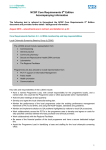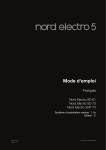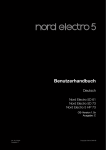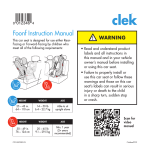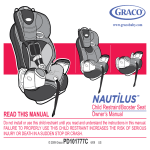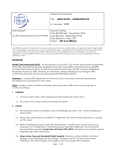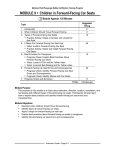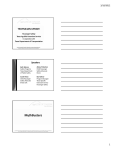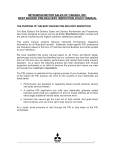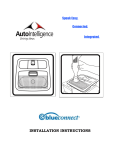Download Mod6_IG - National Child Passenger Safety Board
Transcript
National Child Passenger Safety Certification Training Program MODULE 6 • Lower Anchors & Tethers for CHildren Module Agenda: 50 Minutes Suggested Timing Topic 1. Introduction 2. Lower Anchors and Tether Anchors Description 3. Lower Anchors and Tether Anchors Symbols and Locations • Practice Activity: Locate Lower Anchors and Tether Anchors in Owner’s Manuals and Vehicles 4. Lower Anchor and Tether Anchor Misuse 5. Progress Check and Summary TOTAL 2 5 30 5 8 50 Minutes Module Purpose This module addresses Lower Anchors and Tethers for CHildren – LATCH – an alternative system to install car seats in vehicles. You will also teach participants about lower anchor and tether anchor symbols and locations. Module Objectives • • • Describe lower anchors and tether anchors. Recognize lower anchor and tether anchor symbols and locations. Explain lower anchor and tether anchor best practices to caregivers. Special Media, Materials, and Resources • • • • • • Several vehicle owner’s manuals (use pre-2001 and post-2002 samples including pickup trucks with webbed anchors, if possible) Several vehicles with lower anchors and tether anchors (truck, SUV, van, passenger car) One car seat with flexible lower anchor connectors Copy of a current LATCH Manual (if available) LATCH Manual 2013 Excerpt (TG Appendix) One car seat or booster seat with rigid lower anchor connectors Video Titles and Times None Instructor Guide • Page 6-1 Activities • • Practice Activity: Locate Lower Anchors and Tether Anchors in Owner’s Manuals and Vehicles Final Progress Check Preparation • • • • Prepare for the activity and progress check. Ensure that you have enough owner’s manuals and vehicles of different types. It is not possible in this course to teach participants every possible misuse of the lower and tether anchors. Therefore, it is critical to role model what correct use looks like and how to use low anchors and tether anchors properly at every opportunity. Prepare to discuss LATCH as a system. Avoid referring to only lower anchors as LATCH. This is also true with the tether anchor. Lower anchors and the tether anchor should NOT be called LATCH unless they are used together. Instructor Guide • Page 6-2 What To Do 1. Talking Points • Activity Directions & Summaries Introduction Display PPT 6-1. Present module purpose. This module addresses Lower Anchors and Tethers for CHildren – LATCH – an alternative system to install car seats in vehicles. You will also learn about lower anchor and tether anchor symbols and locations. Display PPT 6-2. Present module objectives. As a result of this module, you will be able to: • • • 2. Describe lower anchors and tether anchors. Recognize lower anchor and tether anchor symbols and locations. Explain lower anchor and tether anchor best practices to caregivers. Lower Anchors and Tether Anchors Description Reference TG page 6-1. Display PPT 6-3. Define LATCH. LATCH stands for Lower Anchors and Tethers for CHildren. • LATCH is an alternative system to install car seats in vehicles using two lower anchors and one tether. For rear-facing car seats, only the two lower anchors are used unless the manufacturer allows rear-facing tethering. • If you are referring to the lower anchors and tether it is a LATCH system. • In LATCH use, the car seat must have a set of lower anchor connectors that attach to the vehicle’s set of lower anchors and tether anchors. Display PPT 6-4. Instructor Guide • Page 6-3 What To Do Talking Points • Activity Directions & Summaries • Each LATCH set in the vehicle is made up of two lower anchor bars and one tether anchor. If there are lower anchors in a vehicle seating position, there is usually a tether anchor for that seating position. Use a tether when forward-facing. NOTE: Not all types of car seats will use a tether anchor. We will learn more about that in later modules. Provide additional information about LATCH. • LATCH attaches the car seat or booster seat to the vehicle through anchor points installed in the vehicle and connectors on the seat. • Most vehicles made after 2002 have at least two complete LATCH systems (lower and tether anchors) and one additional tether anchor. • Only seating positions that have a standard LATCH system, as defined in the vehicle owner’s manual, should be used for lower anchor installation unless otherwise specified in both the manufacturer and car seat or booster seat owner’s manuals. Many caregivers install their seat with lower connectors in the rear-center seating position when the vehicle manufacturer may not allow it. • Some vehicles offer standard LATCH in the center, and some vehicle and child restraints manufacturers allow LATCH in the center, even if it is not a standard LATCH position. Remember, two lower connectors should never be attached to one lower anchor. • NEVER install a car seat or booster seat using lower anchors and the seat belt at the same time unless specifically allowed by both the seat and vehicle manufacturers. It should be one system or the other because that is how the car seat was crash tested. • ALWAYS look in the owner’s manual to determine if a vehicle has lower anchors and tether anchors, and to see which seating positions have a LATCH system and which have only a tether anchor. • A seating position with a tether anchor only and no lower anchors is not called LATCH. That seating position would use the tether and seat belt to secure a seat. Instructor Guide • Page 6-4 What To Do Talking Points • Activity Directions & Summaries Reference TG page 6-2. Display PPT 6-5. Define tethers. A tether connector holds the back of the car seat and some booster seats against the vehicle seat to reduce the amount of forward and side movement. • • Review additional tether information. A tether connector can reduce the distance that the child’s head moves forward in a crash by 4 to 6 inches. This lessens the risk of head injuries in a crash. Tether anchors have upper weight limits that vary by vehicle manufacturer. • Tether may be used with lower anchors or seat belts. • Contact the vehicle manufacturer customer service help line to determine the actual tether and lower anchor weight limits approved for that particular vehicle. • Tether anchors have been required in three vehicle positions since September 2000, but many vehicle manufacturers provided them or marked the tether anchor location in older vehicles so that tether anchors could be installed at a later date. • Tether anchors are sometimes listed under straps in owner’s manuals and are frequently the last item discussed under the car seat or booster seat section (a useful tip if you are having trouble locating that term in the manual’s index). • Tether anchors may look very different in pickup trucks. Refer to the vehicle owner’s manual to ensure their correct use. • Encourage caregivers to use tether connectors for forward-facing children whenever possible. Also encourage caregivers with young children and older vehicles to have tether anchors installed in their vehicles. • Car seats can be secured using lower anchors and tether or a seat belt and tether. Instructor Guide • Page 6-5 What To Do Talking Points • Activity Directions & Summaries [INSTRUCTOR NOTE] [Point out tether anchors made of seat belt webbing if you use pickup trucks in your class.] Describe some exceptions. Convertibles, sports cars, school buses, and some heavy trucks (over 10,000 pounds gross vehicle weight/GVW) are not required to have tether anchors, though some of these vehicles are still required to have lower anchors. • When a vehicle has lower anchors, but there is no tether anchor, consult the car seat owner’s manual to see if installing the seat with only lower anchors and no tether is allowed. If the owner’s manual says you must use both lower and upper connectors, or if you do not know or cannot find out, then use the seat belt to secure the seat. • An approved integrated (or built-in) car seat may take the place of one of the LATCH positions NHTSA requires. Reference TG page 6-3. Review tips for discussing LATCH systems. Ask question and respond to comments. Review the Tips for Discussing LATCH Systems. • Anchor weight limits are not always stated in the vehicle or car seat owner's manual. If the manufacturer offers no weight limit, do not use lower anchors or the tether anchor if child + car seat weight is more than 65 pounds. • If a caregiver wants to use the center rear seating position that does not have a LATCH system, they should use the seat belt to secure the car seat. They should also use the tether anchor if there is one for the middle seat. • Whenever possible, have the caregiver locate the tether anchor and lower anchors in their vehicle. • Use the current LATCH Manual (Safe Ride News) for information on installing LATCH. Q. What questions do you have about LATCH? Instructor Guide • Page 6-6 What To Do 3. Talking Points • Activity Directions & Summaries Lower Anchors and Tether Anchors Symbols and Locations Reference TG page 6-3. Display PPT 6-6. Identify universal LATCH symbol. If a lower anchor or tether anchor is hidden behind fabric or a cover in the vehicle, a symbol near the anchor location will identify its position. Display PPT 6-7. Identify tether anchor locations. Tether anchor possible locations include: • • • • • • Ceiling above rear seating positions Rear window shelf Back of vehicle seat Floor of rear cargo area Under vehicle seat Under a flap or door Display PPT 6-8. Identify lower anchor locations. Lower anchor positions can be visible or hidden. • • Conclude topic. Labels, buttons, or tags identify lower anchor locations when they are hidden. Most vehicles cannot be retrofitted with lower anchors. It is generally not permitted to connect more than one tether hook per tether anchor. Exceptions to this rule are the tether anchors in some pickup trucks. The same is usually true for lower anchors. They can only be connected to one lower anchor connector. • Many vehicle owner manuals have diagrams showing available LATCH positions. Sometimes there are restrictions on how many seating positions can be used at the same time, often due to overlap (example from vehicle owners manual – 2013 Chevy Malibu). Instructor Guide • Page 6-7 What To Do Talking Points • Activity Directions & Summaries [INSTRUCTOR NOTE] [Tell participants that there is a nationally recognized LATCH Manual that is a good CPS Technician resource (www.saferidenews.com).] Ask question and respond to comments. Q. What questions do you have about LATCH symbols and locations? Conduct practice activity and debrief. We have covered a lot of information about LATCH. Let’s go out to vehicles to practice locating lower anchors and tether anchors in vehicles. We will first locate this information in vehicle owner’s manuals. 1. Using the owner’s manual section provided, find the information listed below about LATCH in the owner’s manual. 2. Locate lower anchor and tether information in two different vehicle owner’s manuals. Reference TG page 6-5. [INSTRUCTOR NOTE] [Conduct this two-part practice activity outside in vehicles. Have selected manuals available for participants to look for and locate tether and lower anchor information. Give participants 5 to 8 minutes for this practice activity. Provide feedback to correct any mistakes. Mention tether anchor retrofit capabilities for older vehicles. Remind them that many vehicles did not have lower anchors before 2003. Once participants have finished the first part of the activity, move on to the second part.] Continue to conduct practice activity and debrief. Now locate lower anchors and tether anchors in three different vehicles. 1. Inspect three vehicles to see some differences in the location of LATCH systems and the words/symbols to describe them. Keep in mind that the LATCH system has two lower anchors and one tether anchor. 2. Document the number of seat belts, number of LATCH seating positions, and tether anchors in the three vehicles on the table below. Instructor Guide • Page 6-8 What To Do Talking Points • Activity Directions & Summaries 3. At the end of this activity, an Instructor will install a car seat using LATCH. [INSTRUCTOR NOTE] [Give participants 10 minutes for this practice activity. Arrange participants into small groups and assign a member of the teaching team to each vehicle. Have participants rotate through three vehicles to see different placements and locations of lower anchors and tether anchors. They will practice this later individually. Show two demonstrations – one forward-facing and one rear-facing. You can also use both rigid and non-rigid lower anchors for demonstrations. When participants return to the classroom, ask about their experience. Ask if they had noticed lower anchors and tether anchors in their vehicles before the class. The instructing team can provide feedback to participants on their worksheets outside or back in the classroom. Always refer caregivers to car seat and booster seat instructions and vehicle owner’s manuals. There will be times when you will need to advise caregivers that some questions do not have clear answers.] [INSTRUCTOR NOTE] 4. [Tell participants that a list of Child Restraint and Vehicle Manufacturers can be found on the NCSPB website. They should keep this list handy at checkup events.] Lower Anchor and Tether Anchor Misuse Reference TG page 6-6. Review common lower anchor and tether anchor misuse. Any product can be misused. Misuse rates increase when instructions are not read. • Your job is to help caregivers use their car seat or booster seat according to the manufacturer instructions and encourage them to use the vehicle owner’s manual whenever they transport children. Instructor Guide • Page 6-9 What To Do Talking Points • Activity Directions & Summaries • The only way to know for certain that lower anchors and tether anchors are being used correctly is to use the vehicle and car seat owner’s manuals for guidance. • Both lower anchors and tether anchors have weight limits set by the vehicle and car seat/booster seat manufacturers. To determine the limits of these systems, you must refer to both the car seat and vehicle owner’s manual. • If there are different weight limits listed, the lower limit must be used. If there is no stated weight limit for the vehicle lower anchors or tether anchors, and the car seat lower anchors or tether anchors, you MUST assume that they may be used until the total weight of the child and car seat equals 65 pounds. Display PPT 6-9. Common lower anchor errors include: • • • • Lower anchor connectors not firmly attached to bars Using a non-approved vehicle seating position Using seat belt and lower connectors at same time (unless allowed by manufacturer) Securing two car seats or booster seats on one anchor bar Common tether anchor errors include: • • • • • [INSTRUCTOR NOTE] Not using tether when available Not attaching tether via the vehicle manufacturer instructions (routing the strap incorrectly) Connecting to the wrong tether anchor Tether strap too loose Tether strap used over the vehicle manufacturer weight limit [Briefly review the Preventing Tether Errors information located in TGs on page 6-6. • Head restraints may make it hard to use tethers the right way. • Some head restraints cannot be removed to allow for a tether strap installation. Instructor Guide • Page 6-10 What To Do Talking Points • Activity Directions & Summaries • 5. Tether straps generally go straight back from the seat to the tether anchor and go under adjustable head restraints or over or around non-adjustable head restraints. Check the vehicle owner’s manual for model specific information.] Progress Check and Summary Reference TG page 6-7. Display PPT 6-10. Reinforce how to explain best practices to caregivers. [INSTRUCTOR NOTE] Conduct a progress check. There are key questions to answer related to LATCH. [Review the key questions also located in TGs.] Let’s review what we learned in Module 6 through a final progress check. Answer the questions in the TGs to prepare for conversations you will have with caregivers to educate them about LATCH. Write down responses in your TG. Remember that caregivers need to understand that they have two safe choices for securing their child’s car seat. Use the vehicle and car seat or owner’s manuals to learn about the vehicle and the seat. Some booster seats are recommended to be installed into the vehicle with lower anchors and/or tether anchors to prevent it from becoming a projectile when unused. [INSTRUCTOR NOTE] [Divide the class into three small groups. Give each group one of the three best practice scenarios to solve along with the associated owner’s manual. For Scenario #2, the 1998 Chrysler four-door Sebring is listed in the LATCH Manual. The TG Appendix has the LATCH Manual Excerpt – Appendix A Vehicle Information to point out how to find the part number. Tell participants they have 5 minutes to come up with their answers. Instructor Guide • Page 6-11 What To Do Talking Points • Activity Directions & Summaries Here are the scenario answers. 1. What should you tell caregivers regarding where to find all the tether anchors and lower anchors in their car, van, SUV, or truck? Answer: • Look in the owner’s manual first. Some manuals may make it obvious with terms easily found in the index under “Tether or Strap.” • Always look in the child passenger safety section of the owner’s manual for more specific details. • The manual should show the lower anchor and tether anchor labels (icons) sometimes located in the vehicle’s seating position where the system is located. 2. What can you tell a caregiver who has a 1998 Chrysler 4-door Sebring with no tether anchor and who wants to have one installed? Answer: • Offer encouraging words by explaining where the part number can be found and telling the caregiver that adding the anchor so they can use the tether is very beneficial for their child's safety. • Advise the family to take the part number (and technical service bulletin number) to the dealer and have the tether anchor installed there. Generally, in the United States, vehicle manufacturers will provide one tether anchor retrofit free to their customers. Use the vehicle manufactures service manual, customer service line or the LATCH Manual if available. • The part number is specific to the model and year of manufacture. Lower anchors are generally not retrofitted. Instructor Guide • Page 6-12 What To Do Talking Points • Activity Directions & Summaries 3. The vehicle has a lower anchor and tether anchor weight limit to 40 pounds. The car seat is rated to 65 pounds. At what weight limit would you need to install the seat using a seat belt instead of lower connectors? Answer: • If the car seat harness serves children up to 65 pounds, but the vehicle owner’s manual says to use the lower anchors and tether anchor for up to 40 pounds only, the caregiver must use the seat belt to comply with the vehicle manufacturer’s instructions. • LATCH and the seat belt installations should be done according to manufacturer’s instructions. Encourage the caregiver to attach the tether whenever possible as long as the tether anchor weight limit is at least 65 pounds child weight. Always encourage tether use when use is possible with forward-facing car seats that are installed in the vehicle with the seat belt up to the weight limit of the tether anchor.] Ask question and respond to comments. Q. What remaining questions do you have about LATCH and your role in explaining best practices to caregivers? Conclude module. We have covered what you need to know about seat belt systems, vehicle occupant protection systems, and lower anchors and tethers. We’ll now move to the first skills assessment on identifying seat belt systems. After the assessment, the next module will introduce car seats before we move on to specific types of car seats and booster seats for children of different ages. Instructor Guide • Page 6-13 What To Do Talking Points • Activity Directions & Summaries Instructor Guide • Page 6-14 National Child Passenger Safety Certification Training Program Skills Assessment #1: Identify Occupant Protection Systems INTRODUCTION Skills Assessment #1: Identify Occupant Protection Systems addresses knowledge and skills taught in Modules 1 to 6. Objective Technician candidates demonstrate their ability to identify different types and parts of five vehicle occupant protection systems. Time for Completion The recommended time limit for Skills Assessment #1 is 60 minutes. PREPARATION 1. Depending upon class size, vehicles available, and parking arrangements, determine the number of vehicles needed to allow for efficient and effective identification of vehicle systems. Use information from the Participant Vehicle Occupant Restraint Systems Details forms to assist in vehicle selection. If possible, use duplicate stations to keep participants moving through the assessment. 2. Identify the required components in vehicles available for Skills Assessment #1 and clearly mark the seating positions as systems to identify. Mark vehicles with visible numbers and questions (e.g. colored paper or cards) that indicate which specific system participants are asked to identify. For example: • • Question for Vehicle/System #1: Identify the vehicle occupant protection system(s) in front passenger side. Question for Vehicle/System #2: Identify the vehicle occupant protection system(s) found in rear center position. 3. For Instructor reference, make a master list of questions, answers, and specific vehicles used during this assessment. 4. Provide owner’s manuals for two to three stations and, when possible, make copies to help move the assessment along. NOTE: Switchable latchplates are identified in the course. However, because they may not be readily available in vehicles used at each training site, they are not included in Skills Assessment #1. ADMINISTRATION GUIDELINES 1. Review all instructions for Skills Assessment #1 with the class prior to conducting it (on next page). 2. No talking among participants is allowed during the assessment process. 3. Have participants complete all information lines on the forms before the assessment begins. Do not sign a form without the correct participant name filled in at the top. 4. Participants may refer to any or all of the course resources or vehicle instructions to complete this assessment. Tell participants that finding the page numbers in owner’s manuals by looking in the index is permissible and recommended. Instructor Guide • Page 6-15 National Child Passenger Safety Certification Training Program Skills Assessment #1: Identify Occupant Protection Systems (continued) 5. If there are two retractors (ALR, ELR, Switchable) or types of safety belt systems (manual and automatic), BOTH retractors and safety belt systems must be identified to be considered a PASS. 6. Mark a row as failed if any of the answers are incorrect. Instruct participant to locate the answer in the TG and try again. 7. Should a participant need attempt #3, direct him/her to stop and review the TG again. Encourage the participant to work with an Instructor to find the information and talk through the basics, such as all latchplates and retractors. An Instructor who has not scored that person on that scenario will score the third attempt. 8. Any Instructor who places their ID# on a skills assessment form must provide a signature and Instructor number on the Skills Assessment Instructor Log form for that assessment. 9. Do not provide additional information to participants other than a clarification of instructions. 10. A time limit to complete repeated attempts may be determined at the discretion of the Lead Instructor (LI). PARTICIPANT INSTRUCTIONS Complete Skills Assessment #1 individually. For five assigned vehicles and seating positions, correctly identify the latchplate, retractor, LATCH parts, and air bags. 1. Stand at least 10 feet away from a station while waiting your turn. Carefully identify the Instructor-assigned vehicle and assigned seating location. 2. Answer sections A, B, and C for each of the scenarios. If there is more than one retractor in the assigned seating position, indicate which type it is next to the type. Examples: ALR – lap ELR – shoulder 3. Answer ALL three sections (A, B, and C) for each vehicle scenario correctly to pass. • • • You MUST pass all three sections to pass the scenario. You have up to three attempts to pass each scenario. Instructors will sign off each section (A, B and C) on each attempt. If you need a third attempt to pass, stop and review your TG. A third attempt to pass will be signed off by an Instructor who has not already scored you for that scenario You MUST be able to tell the Instructor how you arrived at each selection after each scenario. Examples: I found the air bag information on page B-42 in the vehicle manual. This is a switchable retractor. I tested it by…. • To pass Skills Assessment #1, you must pass all five scenarios. NOTE: Instructors will NOT tell you which specific part you did not answer correctly just the section. Instructor Guide • Page 6-16
















